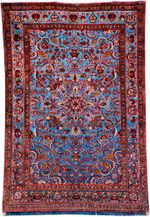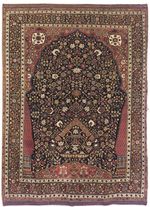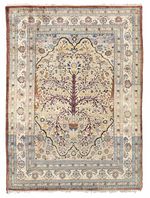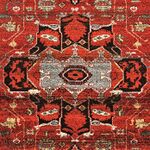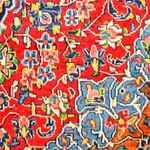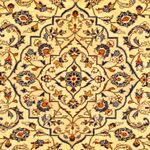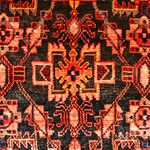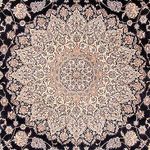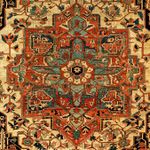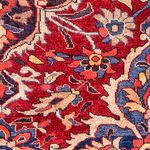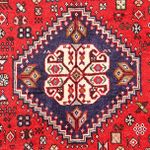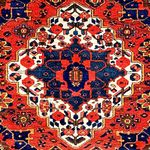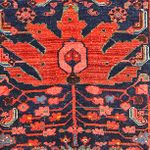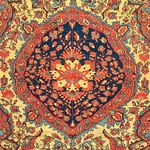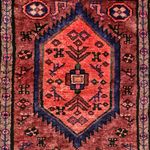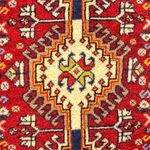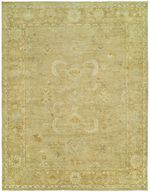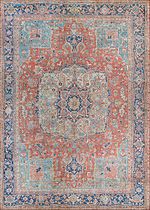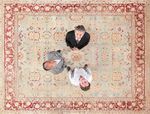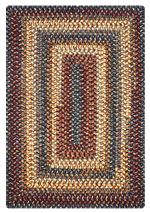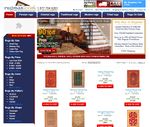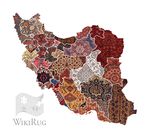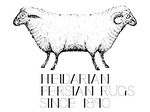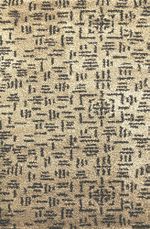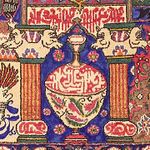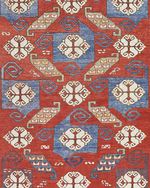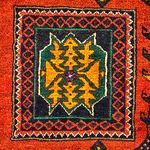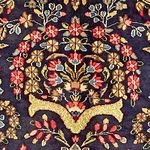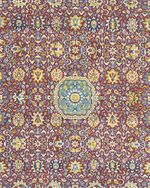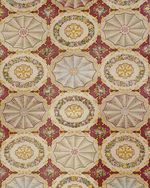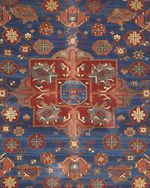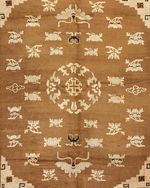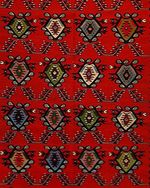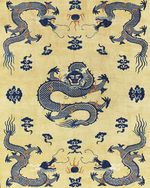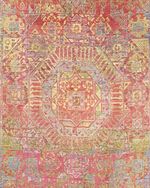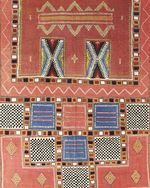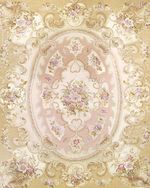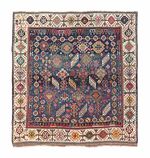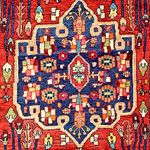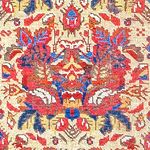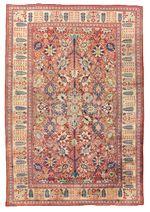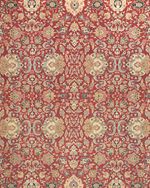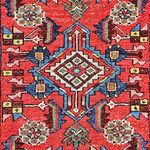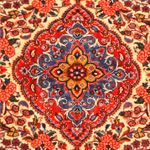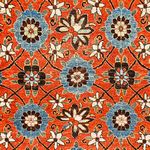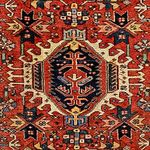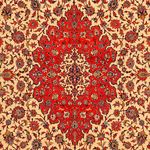Difference between revisions of "WikiRug:Featured Article 2021"
| Line 358: | Line 358: | ||
{{navbar|WikiRug:Featured Article/2021/50|change|plain=y}} | {{navbar|WikiRug:Featured Article/2021/50|change|plain=y}} | ||
{{Clear}} | {{Clear}} | ||
| − | |||
---- | ---- | ||
Latest revision as of 11:13, 15 November 2021
Week 6 2021
- week 1
Weaving in Kashan mainly takes place in Kashan city and its suburbs like Natanz and Josheghan. The knots used in Kashan and its Villages is symmetrical and its warp is known as Farsi. The loom is fixed vertically and usually made of wood. The row counts of the carpets range from 35 to 60 and are even in numbers. 70 knots per 6.5 cm is usually woven for very precious types. The row counts of 30 to 40 knote are very common. The knots are bound together during the carpet weaving(Full article...)
- week 2
Qashqa'ies weave rugs in two types: offset warp and semi-offset warp. Most of the knots are asymmetric (Persian knot). The symmetric knot (Turkish knot) is also popular among them. Two wefts are used after each row of knots. Most of these designs are inspired by other tribal arts and have turned in to tribal weavers styles. In this group the weaver's imagination is materialized in the realm of the colors. The famous Nazem design is a example of this group. The medallion, nazem, prayer-nich, repeated in and out fish, paisley designs are most popular Qashqa'i ones.(Full article...)
- week 3
The used raw material in Isfahan carpet is one of the most delicate wool, coming from central parts of Iran and is colored in the suburb dye houses or in the near towns, using silk in the carpet weaving is very popular in the weaving of silk warp, silk flower, and full silk carpet. One of the most famous and most popular designs on Isfahan carpet is the Toranj corner design. The corner design, Shah Abbasi toranj and Eslimi are quite popular in Isfahan carpets. Other designs used are called: Medallion, repeated Zel-u-Sultani, and Afshan.(Full article...)
- week 4
Tabriz as the main focal point of production of the city-woven carpets in Azerbaijan has been the source of several developments in carpet design. The knot used for weaving is symmetrical (or Turkish knot) and a hook is used for the knot. Tabriz is considered the founder and enhancer of the painting weaving style. The looms used are called the Tabriz loom or non-fixed loom on which warp is windered. (Full article...)
- week 5
The Goravan rugs and carpets have a cotton foundation and a wool pile. The Turkish (symmetric) knot is used. Goravan carpet designs are geometric, with either a medallion or an allover style. In general these carpets are well known for having a large center medallion with medallion sections in the corners. The designs feature large stylized palmettes, leaves, and vines with primitive nomadic motifs and ornaments. (Full article...)
- week 6
Ahar carpets use a Heriz design style and are grouped under Heriz carpets. The rugs and carpets have a cotton foundation and a wool pile. The carpets generally have a brick-red or deep red background. Dark blue was used for the medallion and border. In addition to these colors, ivory, camel, and shades of red, blue, green, rust, and brown were utilized for the design elements. (Full article...)
- week 7
Ardekan carpets are known in the market from the 1920s, and were woven with a Kerman or Yazd design and technique. They were made with a cotton foundation and a wool pile. The Persian (asymmetric) knot was exclusively used. The designs are floral with either a medallion or an allover style. The motifs have palmette, leaf, and vine designs throughout the carpet. (Full article...)
- week 8
Borujerd carpets have semigeometric designs in a medallion or allover style. The rug motifs vary, but are usually palmettes with leaves and vines. Other designs are the traditional Boteh (Paisley), Herati (Fish), Shrub, and Vase motifs. Weavers also used animals, birds, human figures, and tribal devices for the field and border designs. The coloration is primarily reds, with a small percentage of ivory or dark blues used for the back-ground. (Full article...)
- week 9
Nain is a town located in the Isfahan Province of central Iran. In the second quarter of the twentieth century, a number of families from Nain started producing rugs with ISFAHAN patterns. Prior to this there was no commercial carpet industry in Nain. The famous Nain master weaver HABIBIAN made the highest-quality rugs using a four- or six-ply warp. His carpets are signed “Habibian," in Farsi, and are considered valuable today. With the growing demand, Nain manufacturers began to produce and market nine-ply and twelveply carpets starting in the last quarter of the twentieth century. They were made for lower-budget consumers with the same coloration and designs, but in a good to very good grade quality. During this period, carpet producers in the town of Nain and the surrounding area were not able to handle the volume of requests of the world market, and Nain carpet producers began to establish looms in other Iranian provinces such as KHORASAN, SHAHR KURD BAKHTIARI, YAZD, and many other locations to weave Nain style carpets mostly in nine-and twelve-ply qualities to meet the increasing demand. (Full article...)
- week 10
Heriz, a town in the East Azerbaijan Province of northwestern Iran, was a famous weaving village during the nineteenth and twentieth centuries. Heriz rugs and carpets are known in the market from the early nineteenth century. The weavers of Heriz are credited with being the first in Persia to produce room-size and oversize carpets with rustic, nomadic designs. Heriz carpets are well known in the world market and coordinate with the interiors of many European and American homes. They are also in demand for the domestic market, especially in the Azerbaijan Province. Heriz carpets are known to be durable floor coverings. Many villages surrounding Heriz adopted the popular designs of Heriz in the last quarter of the nineteenth century in response to world market demand. Generally, the weavings of these villages are grouped as Heriz carpets abroad, but each village is known individually by name in the Iranian market. The popular villages include Ahar, Bilverdi, Goravan, Karadja, Mehraban, Sharbian, and Sinsari. The famous weaving village of Bakhshaish also switched to Heriz designs for better marketing purposes by the turn of the twentieth century. Although the designs were similar to Heriz, all of these villages possessed easily identifiable characteristics with their chosen motifs, color, and qualities. (Full article...)
- week 11
Ferdos, also spelled Ferdows, is a town located in the Khorasan Province of eastern Iran and is mostly populated by Arab Baluch tribes. In the antique market older Ferdos rugs are known as Arab Boft, which means, “woven by Arab Baluch tribe members.” Before World War II Ferdos formats ranged from tribal items to PRAYER RUGS. After the war many of the Ferdos weavers began to make a new style of rugs and carpets sizes were extended to room dimensions. This nomadic style with simple coloration became successful and was in demand in Western markets.
Meshad dealers for Western clients commissioned some of these room-size carpets. Generally, Ferdos woven rugs are low in grade quality and they were lower in price compared to all other Baluch tribal rugs woven in KHORASAN. (Full article...)
- week 12
Abadeh is a town located on the main road between Isfahan and Shiraz in the Fars Province of southwestern Iran. many Qashqai, Lori and Afshari tribes have settled in Abadeh. They are similar in look to Persian rugs from Shiraz but differ in their use of blue cotton weft. Abadeh is also traditionally where the nomadic Qashqai, during their north/south seasonal migration, would cross. As a result of its unique location, Abadeh’s importance as a market town grew over the centuries – because so many different nomadic tribes passed through it, there was a significant cultural exchange between Abadeh itself, and her many visitors. Abadeh rugs are known in the market from the mid-twentieth century. The designs Abadeh rug are geometric and have SHIRAZ regional tribal styles. The patterns are allover, single medallion, or multiple medallions in the center of the field. Generally, the medallions are lozenge-shaped and surrounded by stylized Hook motifs. Small flower heads, leaves, vines, animals, and birds are applied in the field designs. Early Abadeh rugs, especially those of high quality, have the ZILI SULTAN pattern of vase with flower bouquets and birds on both sides repeated in the field on an ivory background.(Full article...)
- week 13
Bakhtiari Bakhtiari people are a noble, ancient tribe surviving in the Chahar Mahal region of south-central Iran. Primitive Bakhtiari rugs frequently have a checkerboard or garden pattern decorated with trees-of-life, birds, flowers and animals, sometimes realistic, sometimes abstract. Generally these are woven with a Turkish knot. But some very beautiful floral patterns are still produced in the principal town of Shahr Kurd with the Persian knot, showing long, exaggerated medallions reminiscent of an earlier Isfahan style. Color schemes include many shades of brown, rust, yellow ochre, bottle green, beige, dark blue and red. By the turn of the century the Persian carpet industry was recognized by consumers in the Western market. With this growing demand, most Bakhtiari towns and villages began to produce carpets in all sizes, which brought new income to the Bakhtiari population. The designs made are generally semigeometric; some Bakhtiari workshops produced floral styles. The carpets are woven in the allover or medallion design, with Keshti (garden pattern), Lattice, Shrub, Tree of Life, flower bouquet, cypress tree, willow tree, and other natural motifs. Many of the Bakhtiari designs have influences from the surrounding weaving areas, such as FARAHAN in the north, JOSHEGHAN in the east, and from tribes such as the Lori and the QASHQAI from the south. (Full article...)
- week 14
Hamadan rugs are hand woven of the Hamadan Province, located in western Iran. Hamadan and its surrounding villages make up one of the largest trade centers for tribal rugs. Distinctive designs are associated with particular towns and villages in the region. The wool used for weaving the rugs and stair runners is extremely durable as a result of coming from sheep living in higher altitudes with cooler temperatures. The rugs of Hamadan are single-wefted and most of them have a cotton foundation. The Hamadan rugs have symmetrical knots and are coarsely woven with densities of about 40 to 100 knots per square inch. The carpets were woven in standard American sizes, ranging from approximately nine feet by six feet to eighteen feet by twelve feet. Hamadan Shahr Boft carpets are generally medium to good in grade quality. Early Hamadan weavings were made in wool or cotton foundations with a thick wool pile. By the early twentieth century most villages switched to using a cotton foundation with a wool pile. Hamadan city carpets have a cotton foundation with a wool pile. (Full article...)
- week 15
Farahan rugs are hand woven in the north of the Markazi (formerly Arak) Province, located in west central Iran. Farahan is actually a collection of farm towns and small villages with a long and illustrious history of weaving magnificent tribal traditional rugs. In many western countries today, Farahan rugs are known and sold as Mahal, from the city of Mahallat in the district of Farahan. The traditional rugs from this region are of the highest quality and in great demand the world over. The Sarouk is one of the most famous traditional rugs produced in the region. Tribal people meticulously weave Farahan traditional rugs to exacting specifications using the asymmetrical knot. The Persian (asymmetric) knot is invariably used in all weavings. They are made from very good to very fine in grade quality.(Full article...)
- week 16
Zanjan is the capital of the Zanjan Province in northwestern Iran. It is an ancient city with an Azeri population that speaks a Turkic dialect. Zanjan rugs are known in the market from the early twentieth century. Many weaving villages in this province produce rugs that are similar in design and market them with the Zanjan name.
By the late twentieth century, many Zanjan weavers switched from weaving their traditional designs to make rugs similar to those of other cities and villages in the region in accordance with the demand of domestic and foreign consumers.
The rugs have reds, dark blue, or ivory for the background. These colors are interchangeable for the medallions and border. Additionally, different shades of blue, brown, green, gray, and camel accentuate the minor borders, design elements, and outlines.(Full article...)
- week 17
Yalameh is a subtribe of the Lori population in Iran. The Lori, also called “Lor,” is the oldest tribe known in the country. Over the centuries, the Lori population has spread from the west central region to the Persian Gulf in southwestern Iran. The Yalameh is mostly settled in the northern portion of central Iran.
Yalameh background and border colors are reds, blues, ivory, and browns. In addition to these, different shades of green, gray, gold, and cinnamon are used in the design elements.
The designs are geometric and strongly influenced by Lori patterns. The designs are allover or medallion in style. The allover pattern generally has square compartments featuring palmettes or diamond shapes edged by Hook motifs surrounded by tribal design elements.(Full article...)
- week 18
Kalaty Rug Corporation is a family business that for generations aims to set "the gold standard for area rugs". Highly respected for its superior quality handcrafted rugs, the company has built a reputation for its ability to combine color and design to create a broad range of area rugs that portray “Tradition for Today”.
The family Oriental rug business originated in the early 1900s in Iran under Mirza Kalaty’s grandfather, and in 1979 Mirza Kalaty founded the company in the USA. Today, Mirza along with his five sons, Ramin, Mike, Farshad, Ariel and Kamran now run the company, and thus an impressive four generations of experience has gone into building the company. (Full article...)
- week 19
Couristan is an American private company that works in the field of home furnishing. The company founded in 1926, in New York, manufacture and provide carpets, area rugs, roll runner and special shape carpets. Their slogan at Couristan is “Trust, Style, Quality and Innovation”.
Since its establishment, Couristan and its entire team have dedicated itself to a universal commitment of excellence. "Weaving four key components into every product – Trust, Style, Quality and Innovation.(Full article...)
- week 20
CarpetVista has since it was founded in 2005 by Hossein Sadr and Ludvig Friberger grown to become a global leading online retailer of high-quality carpets with sales in over 50 countries. The Swedish private equity company Litorina, through the fund Litorina IV, became the new majority owner in December 2015 and has together with the founders continued to develop the company. Also, They have gathered the information for guidance about buying a handmade carpet or learning more about carpets in their Carpet Encyclopedia website. (Full article...)
- week 21
Nazmiyal Collection was founded in 1980 in New York by Jason Nazmiyal, and since then Nazmiyal is recognized as one of the premier antique rug galleries with some of the most exquisite masterpieces. The Collection features a 5,000 square feet (460 m2) gallery. Nazmiyal Collection provided carpets for use as backdrops in an exhibition of works by artist Paul Thek at the Whitney Museum. The Morgan Library and Museum installed a Nazmiyal carpet during the renovation of their library in 2010. (Full article...)
- week 22
Homespice is an originally Indian family-owned company that manufactures braided rugs, indoor-outdoor rugs, and home accessories. The company founded in 1998 by Junior Gupta. Their designs are based on tradition of history with a fusion of innovation, color, and heritage. As they said their textile history goes back four generations. Starting from desert traders in old Indian cities, and their rugs now come to costumers from the tradition of their history with a fusion of innovation, color and heritage. Their family-owned company was founded in 1998 by Junior Gupta, Originally known as J Quilts. They manufactured and wholesaled primarily handcrafted quilts in country motifs from their factories in India with a small selection of matching braided rugs. In 2004, they re-focused by dropping the quilt line and expanding their handcrafted braided rug and accessories under the Homespice Decor product line. In 2006, they introduced their Out-Durable Stain Proof rug line (now known as Ultra-Durable rugs) and in 2008,they created their Green World braided jute rugs and accessories line. (Full article...)
- week 23
Rugman is a Persian and Oriental rugs online provider, and a third generation of Persian Rugs import/export business founded in 1998 to providing area rugs, witnessing the convergence of centuries old handcrafted tradition with modern technology. Rugman has operations in online Persian and Oriental rugs market both in the United States and Canada.. (Full article...)
- week 24
Persian Carpet is distinguished by its complex and calligraphic nature, emphasizing the design and the line. A curvilinear or floral design is most closely associated with a Persian rug, although geometric designs are used as well. The major production centers can be found in Northwest Persia, Western Persia, Southwestern Persia, Central Persia, Southern Persia, and Eastern Persia. Named after the village, town or district where the piece was woven or by the weaving tribe, each Persian carpet has attributes specific to a geographic region or tribe. Persian rugs from Tabriz is sought after for its exquisite craftsmanship. Very classical in appearance, the central medallion is the layout most frequently used. Kerman is known for its vase technique and vase design. A vase design on a Persian carpet is characterized by an ascending directional layout. Pairs of long stems emerge from elegant vases, intersecting at regular intervals, creating a sort of latticework. A Kashan Persian rug is known for a central medallion layout with arabesques, palmettos, leaves, and other plants, interspersed with small birds or animals. A Mashad Persian rug, made using the asymmetrical knot, often features a round or elongated medallion design that is embellished with pendants and floral elements. Every region brings its own unique characteristics to the art of Persian carpet weaving. (Full article...)
- week 25
Heidarian Rugs is an Iranian family-owned company that produces handmade carpets and kilims, founded in 1890 in Chaharmahal-o-Bakhtiari, Iran. which now it's head office in Tehran, Iran. Heidarian’s rugs are characterized by their craftsmen’s techniques based on peoples’ culture and the tendency of the modern Iranian art toward abstraction and fresh ideas. Heidarian Rugs awarded 3 times in 2007, 2008, and 2009 for The Best Traditional Nomadic Design (2007- Bibijoon design, 2008-Katoli design, and 2009-Setareh design), and 2 times for The Best Traditional/Formal Carpet Design (2008-Sana design, and 2009-Sarvy design).(Full article...)
- week 26
Dynamic Rugs is an American private company that produces Hand made and Machine-made carpets and Roll runners, established in 1994, in Maryland. Dynamic Rugs collections consist of selected manufactures in India, China, Turkey, and Belgium. The annual Icon Honors awards program, among the most prestigious in the gift and home furnishings industry, celebrates excellence in innovation, contribution, branding and achievement, and for 2017 Matthew Rouhanian of Dynamic Rugs was an honoree for career achievement.(Full article...)
- week 27
Kashmar carpets woven in the city or in the surrounding towns are called "Kashmar Khorasan." The carpets have a cotton foundation and a wool pile, with the Persian (asymmetric) knot. The designs are traditionally floral, with a medallion with corner medallion quadrants or allover styles. Some designs have an open field with a large center medallion. The backgrounds are mainly pomegranatered (from cochineal), with dark blues, light blues, ivory, and different shades of green, gold, and brown used for the design elements and border field. Kashmar sizes are made from five feet by three feet to large room dimensions.(Full article...)
- week 28
Kazakhstan is an independent republic located in Central Asia. It was once part of the historic East Turkestan region. For centuries the Kazakh territory was ruled by khans, who controlled and partitioned the land into three regions known as Little Horde in the west, Middle Horde in the east, and Great Horde in the south. The Kazakh people are a Turkic ethnic group; some continue to live as seminomads working in agriculture, raising livestock, and herding sheep. Kazakh rugs have a similar style and coloration to those made in the neighboring region of Kyrgyzstan. They are mostly marketed as Kyrgyz rugs in the trade.(Full article...)
- week 29
Kelardasht is a town in the Kelardasht Valley located in the Mazandaran Province of northern Iran. Kelardasht has a Kurmanji Kurd subtribe population who originally moved south from the Karabagh district in the Caucaus region. The Kurmanji can trace their weaving tradition back for centuries. Kelardasht is the only place in Mazandaran Province that weaves pile rugs. Kelardasht rugs as old as the nineteenth century are known in the market. The rugs have a wool foundation and a wool pile, but at times, cotton is used for the weft. Early Kelardasht rugs characteristically have a very long pile of high-grade wool, a beneficial quality, since Kelardasht has a cold climate for most of the year.(Full article...)
- week 30
Kerman, also spelled Kirman, is the capital city of the Kerman Province in southeastern Iran. It is an ancient city and an important trading center in southern Iran. Kerman carpets are found in museums and the market dating from the early seventeenth century. The city is famous for representing the fine woven art of Persia during the Safavid Dynasty. Kerman carpets have always been in demand for their pleasant colors and unique designs, and are woven in a high grade quality. Over the centuries it has been the pride of the Kerman people to produce very exquisite weavings.(Full article...)
- week 31
The original carpet makers in India were immigrants from Persia, skilled weavers and artisans who moved there during the sixteenth century. Early Indian carpets feature a red background with traditional Persian Safavid carpets designs and weaving techniques. The carpets were produced in established workshops throughout northern and central India, most notably in the cities of Agra and Lahore.
Under Shah Jahan new carpet designs and motifs were introduced, such as the Lattice, Mihrab (prayer arch), Shrub, and single tree. The Polonaise carpets style was also popular. Most often the carpets had a cotton foundation and a wool pile. The asymmetric (Persian) knot was used.(Full article...)
- week 32
Spain is known for producing some of the earliest European floor coverings. Early carpets were made for royalty, nobility, and the Church. Queen Eleanor of Castile (1241-1290) brought carpets to England after her marriage to King Edward I (r. 1272-1307) in the latter part of the thirteenth century. These carpets were from Granada and created great interest in England, as carpets were practically unknown in Britain at that time.
Spain became the leader in commercial carpet manufacturing in Europe by the fifteenth century.(Full article...)
- week 33
Most nineteenth and twentieth-century Turkish rugs are coarsely woven with a knot density below 50 knots per square inch. With few exceptions, the symmetric knot is used. Most rugs are woven on a wool foundation with a cotton foundation increasingly used from the turn of the century. Wefts are usually unplied, with two shoots between each row of knots. Some silk rugs have been woven in Turkey. Designs tend to be prayer rugs and medallions rather than all-over patterns.
Turkey has been one of the most prominent Oriental carpet producers in the world. The weavers of Turkey were highly talented and creative with influential designs and techniques. Turkey is credited with the development and advancement of folk art weavings over the centuries.(Full article...)
- week 34
Mongolian Carpet or Mongolian Rug is one of the eastern rugs that woven in Mongolia.
Traditional rugs of Mongolia are quilted felt rugs (shirdeg or toiruulga). There are similar felt tent flaps and mats (olbog). The attribution of old pile rugs (xives) to Mongolia is highly speculative. The earliest rugs so attributed are from the nineteenth century. These rugs show Chinese design influences. The field consists of small geometrical motifs in a dense all-over pattern.(Full article...)
- week 35
Bulgaria is a country located in Eastern Europe. In the nineteenth century it was known for making flatwoven mum rugs in the folk art style. Some of the weavings include Anatolian (Turkish) motifs, because Bulgaria was once under the rule of the Ottoman Empire. These rugs were mainly woven on household looms in small sizes for personal use.
Bulgarian pile rugs and carpets are known in the market from the first quarter of the twentieth century. The carpets were woven under government supervision and regulations, and were manufactured in workshops with precise design and color execution.(Full article...)
- week 36
Early Chinese carpets are simple in design and perfectly drawn. The motifs were strongly influenced by Buddhism and were commonly painted on decorative objects, especially ceramics. The carpets were made for daily use or pillar decorations in temples and palaces. Early Chinese carpets have a cotton or silk foundation and a wool pile. Rare examples of silk pile carpets are found in the antique trade and at auction. The Persian (asymmetric) knot was always employed. The designs were woven in medallion or allover styles. Some carpets were made with several medallions in the field with a circular or moon-shaped design.(Full article...)
- week 37
Egyptian weavers reproduced Oriental designs from Sultanabad and Serapi in Iran, and from Amritsar in India. These styles are still fashionable today and are in demand by decorators and consumers.
Egypt today is an active Oriental rug supplier to the world market. The quality of recent Egyptian carpets ranges from medium to fine in grade. The dimensions range from approximately nine feet by six feet to oversize living room formats. A small percentage of scatter rugs up to six feet by four feet and runners are also made.(Full article...)
- week 38
Kazakhstan is an independent republic located in Central Asia. It was once part of the historic East Turkestan region. For centuries the Kazakh territory was ruled by khans, who controlled and partitioned the land into three regions known as Little Horde in the west, Middle Horde in the east, and Great Horde in the south. The Kazakh people are a Turkic ethnic group; some continue to live as seminomads working in agriculture, raising livestock, and herding sheep. Kazakh rugs have a similar style and coloration to those made in the neighboring region of Kyrgyzstan. They are mostly marketed as Kyrgyz rugs in the trade.(Full article...)
- week 39
Moroccan rugs are categorized in two styles: urban and rural. Urban-style rugs were made in the city of Rabat beginning in the eighteenth century. Rabat rugs are geometric, with design and color influences from early Anatolian (Turkish) and Spanish weavings. They have mainly a medallion style and traditional Anatolian rectangular panels at the upper and lower ends of the field. Hook and Star motifs, flower heads, leaves, vines, and other design elements are woven in the background and borders.(Full article...)
- week 40
Most nineteenth and twentieth-century Turkish rugs are coarsely woven with a knot density below 50 knots per square inch. With few exceptions, the symmetric knot is used. Most rugs are woven on a wool foundation with a cotton foundation increasingly used from the turn of the century. Wefts are usually unplied, with two shoots between each row of knots. Some silk rugs have been woven in Turkey. Designs tend to be prayer rugs and medallions rather than all-over patterns.
Turkey has been one of the most prominent Oriental carpet producers in the world. The weavers of Turkey were highly talented and creative with influential designs and techniques. Turkey is credited with the development and advancement of folk art weavings over the centuries.(Full article...)
- week 41
Early carpets from England are important and are appreciated by interior designers and their discerning clients in the world market. English carpets mainly have a cotton foundation, although some early examples have a wool or hemp foundation; a combination of wool with either a hemp, linen, or jute weft was also used. The pile is made of wool. The Turkish (symmetric) knot is used. English carpets are made in all grade qualities. The dimensions range from approximately nine feet by six feet to palace sizes.(Full article...)
- week 42
The original carpet makers in India were immigrants from Persia, skilled weavers and artisans who moved there during the sixteenth century. Early Indian carpets feature a red background with traditional Persian Safavid carpets designs and weaving techniques. The carpets were produced in established workshops throughout northern and central India, most notably in the cities of Agra and Lahore.
Under Shah Jahan new carpet designs and motifs were introduced, such as the Lattice, Mihrab (prayer arch), Shrub, and single tree. The Polonaise carpets style was also popular. Most often the carpets had a cotton foundation and a wool pile. The asymmetric (Persian) knot was used.(Full article...)
- week 43
The most original Qashqa'i rug is the one which its warp, weft and den are made of hand-spined wool of the tribes sheep and is colored by the Sahara plant and flowers and after putting the warp on the loom, it is woven according to the weavers own designs, plans and patterns. Of course, because of the recent changes in the life and possibilities of the tribe to provide the raw material, using cotton warp and weft is well popular.
The designs of Qashqa'i carpet include two main groups: The first group which has been woven since years ago with one single design with a little change. In this group the designs are subjectively woven.(Full article...)
- week 44
Gholtogh Rug designs have a vast variety woven by mental image; weaving by Ornak (a piece of carpet) is of course seen in some villages. From a long time ago, Tabarzini, Shahrak, Shah Bolaghi, Medallion and Comer, Gul Mirza Ali and Dahan Azhdari have been widespread but currently Shamseh Medallion design woven in the form of double weft is famous. There are several borders for Gholtogh carpets but Tousbagha (Tortoise), Apple Blossom, and Farhad Mirza are more conspicuous. Designs are pectinated and geometrical.(Full article...)
- week 45
Afshar hand-weaves have quality raw materials and weave. Afshars have woven different kinds of weaves from a long time ago with no overt start time of weaving. Afshar tribe has a sheep breed homonym with this tribe yielding excellent and long piles, only existent in dark color. Tribal women sort out yams, turn them to hand-spun piles and apply them to carpet, kilim, Hint gloves and saddle.
Afshar carpets among tribal and rural carpets feature a high density. and good quality They are woven in all sizes: Rug sized, Zar' and a half, Zar' and charak, Pushti, Runner, Doormat, Kharak. Afshar carpets were produced as "Takht Baf" (flat-weave) and "Nim-Lool" (semi-offset warps) in old times: currently as "Lul-Baf" (completely offset warps). The knot, symmetrical (Turkish) knot, is tied by hand.(Full article...)
- week 46
The excellent quality of the raw materials used comes from excellent local wools and the neighbouring tribes like shahsavans, Special dyeing methods in Azerbaijan is better accomplished due to the soft Heris water and its salts make the fibers better absorb colors.
The design in Heris carpet enjoys a wide variety of choices. Beside the designs like medallion, sampler and afshan the corner-medallion design is the main pattern in which a big usually eight-sided medallion has turned to be the distinctive element of Hens carpet.(Full article...)
- week 47
Rugs of Pakistan are woven on a cotton foundation with the asymmetric knot. The cheapest grades may have jute wefts. Wools are local or blended with New Zealand or Australian wool for the finer grades of rugs. Where designs copy Persian models, offset warps are used, while warps are not offset for the “Bokhara” designs. Knot densities for Pakistani rugs are expressed as: (knots per horizontal inch)/ (knots per vertical inch). Thus, 11/22 equals 11 x 22 or 242 knots per square inch.(Full article...)
- week 48
Spain is known for producing some of the earliest European floor coverings. Early carpets were made for royalty, nobility, and the Church. Queen Eleanor of Castile (1241-1290) brought carpets to England after her marriage to King Edward I (r. 1272-1307) in the latter part of the thirteenth century. These carpets were from Granada and created great interest in England, as carpets were practically unknown in Britain at that time.
Spain became the leader in commercial carpet manufacturing in Europe by the fifteenth century.(Full article...)
- week 49
Zagheh rugs are hand-woven Persian tribal carpets made in the Kurdish nomadic districts of Northeastern Iran. Zagheh is the name given to a group of nomadic people living in the surrounding area of Hamadan. The bright colors and geometric shapes are typical of tribal weaving from this area of Iran. A rug such as this takes a nomadic woman, sometimes working with her daughter, several months of concentrated weaving to complete on a crude loom on the ground outside the family tent. Most rugs woven by tribal people are intended for their own use as floor coverings or sleeping mats.(Full article...)
- week 50
Jozan is a town in the Arak (Markazi) Province of west central Iran and is located near the famous weaving village of Sarouk. Jozan rugs dating from as early as World War I are known in the market. The rugs are categorized as Sarouks because of the similarity in textures; at times they are called "Jozan Sarouk" in the trade.
Jozan rug designs are semigeometric and frequently have a pendant-shaped medallion in the center and a stylized quarter-medallion in each corner of the background. The field has an allover style of vines with blossoming flowers, flower sprays, and leaves.(Full article...)
- week 51
Varamin rugs are categorized in the trade under two time periods, the last quarter of the nineteenth century and 1920s to the present day.
Early Varamin rugs were woven by the Shahsavan tribe, which moved south from northwestern Persia and settled in Varamin.These rugs are geometric and sometimes have Minakhani (rosette-linked trellis) motifs with tribal design elements in the field. Other pieces are more strongly geometric, with abstract small medallions and other devices derived from flatwoven mum rugs. The rugs have a wool foundation and a wool pile. The Turkish (symmetric) knot is employed. .(Full article...)
- week 52
Karadja Iran (Persia). Karadja, also spelled Karaja, is a village located in the East Azerbaijan Province of northwestern Iran. The population is Azeri in origin, speaking a Turkic dialect. Karadja rugs and carpets are known in the market from the last quarter of the nineteenth century. These weavings are categorized in the Heriz carpet group.
Karadja carpet designs are geometric, with either a medallion or allover style. In general, these carpets are known to have one, two, or three medallions in the center field or multiple pendants throughout the field.(Full article...)
- week 53
Isfahan, also spelled Esfahan, is an important city and province located in central Iran. It is the capital of the province and is one of the largest cities in Iran. Isfahan is a historic city and is regarded as symbolic of culture and art dating back to the Safavid Dynasty. Isfahan became the capital city beginning in the late sixteenth century, and the School of Art was established there during this period. Under the Safavids the Islamic Shia sect was established in Persia, and famous mosques and palaces were built in the capital and other cities. Today these buildings are considered some of the finest examples of Persian architecture. In Isfahan the Safavid court also established and supervised the handcrafted art forms of carpet weaving, ceramics, miniature painting, metalwork, velvet manufacturing, and garment printing..(Full article...)
